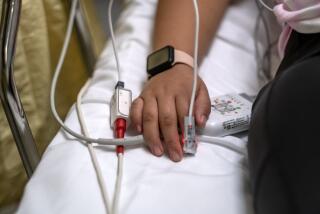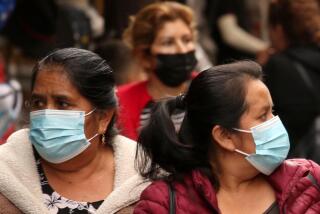Swamped hospitals fear an ER emergency
- Share via
WASHINGTON — On Long Island, N.Y., hospitals are scrambling to bring extra workers in to handle a 50% surge in visitors to emergency rooms. In Galveston, Texas, the local hospital ran out of flu testing kits after being overwhelmed with patients worried about having contracted swine flu.
At Loma Linda University Medical Center near San Bernardino, emergency room workers have set up a tent in the parking lot to handle a crush of similar patients. In Chicago, ER visits at the city’s biggest children’s hospital are double normal levels, setting records at the 121-year-old institution.
So far, few of the anxious patients have had more than runny noses. But the widening outbreak of swine flu, also known as H1N1 flu, is exposing a potentially critical hole in the nation’s defenses.
Across the country, emergency care facilities are straining at the seams even though the outbreak is relatively small and the federal government has launched a mammoth disease-control effort -- dispatching antiviral drugs to states, attempting to contain the limited number of cases and beginning to develop a vaccine against it.
“It is a major Achilles’ heel in our state of readiness,” said Dr. Irwin Redlener, director of the National Center for Disaster Preparedness at Columbia University. “If we get a situation that is really out of hand with large numbers of people affected, I fear that our hospital and healthcare facilities simply won’t have the materials or even the staffing to respond,” he said.
Redlener and others are quick to point out that the outbreak is still a long way from such a critical stage.
Of the 136 cases of H1N1 flu authorities had confirmed in the United States as of Thursday night, only a handful required hospitalization.
By contrast, the Department of Health and Human Services’ moderate pandemic influenza model, based on the last flu pandemic in 1968, envisions 90 million Americans becoming infected and 865,000 requiring hospitalization.
“If the outbreak stays in what I would characterize as its present mild form, I think we’re in great shape,” said James Bentley, senior vice president at the American Hospital Assn. “The key question becomes how many people at any one time have the flu, and how many people have it severely.”
Prompted by the global SARS and avian flu outbreaks this decade, federal health officials and hospitals nationwide have been working to beef up preparations for possible disease outbreaks, helped by more than $2 billion in federal grants.
Hospitals have increased their supplies of staples such as face masks, and many have trained employees to care for patients out in the field.
In the last three years, California has spent more than $400 million to upgrade its readiness, including purchasing three fully equipped mobile hospitals and nearly 7,200 ventilators to respond to an outbreak of respiratory illness.
“Very real progress has been made,” said Dr. Richard Waldhorn, distinguished scholar at the Center for Biosecurity of the University of Pittsburgh Medical Center who recently completed a study of the federal preparedness initiative.
But Waldhorn and others said the serious gaps remain, which would quickly become apparent if the current outbreak worsens.
Even some public health officials acknowledge that supplies of critical equipment such as ventilators could be seriously taxed in case of a full-blown pandemic.
“When you get all states involved, it certainly is more of problem,” said Dr. Gregg Pane, who directs the National Healthcare Preparedness Program at the Department of Health and Human Services.
Hundreds of millions of face masks would be required, Waldhorn said.
Across the country, there are already signs of strain.
In Galveston, workers at the hospital saw the flood of ER patients begin early Sunday morning after news reports of flu-induced closures of public facilities across the border in Mexico, said Dr. Angela F. Gardner, an assistant professor of surgery and emergency medicine at the University of Texas Medical Branch in Galveston.
By that night, all but seven of the hospital’s test kits were gone.
Gardner said they found no cases of the H1N1 virus. But the crowds have continued, even as the hospital struggled to provide care to other patients.
“When they come in, we don’t know who may be really ill and who isn’t,” said Gardner, who is also president-elect of the American College of Emergency Physicians. “You don’t want to turn people away who may be sick.”
In Chicago, Children’s Memorial Hospital saw 394 children in its emergency room Wednesday, more than double the number on a typical day. And at midnight, about 80 children were waiting to be seen, mostly for flu symptoms, forcing the hospital to open new space to accommodate the crowd.
“That’s virtually unheard of,” said hospital spokeswoman Kathleen Keenan, who like many medical officials urged people to check with their primary care doctors before going to the ER.
In Los Angeles, several hospitals are also reporting increased numbers of patients in their emergency rooms, though the surge hasn’t caused hospitals to begin diverting other patients, said Cathy Chidester, director of Los Angeles County’s Emergency Medical Services Agency.
“Some of them don’t even have the sniffles. They’re just worried,” Chidester said.
The strains on emergency rooms have been exacerbated by cutbacks across the healthcare industry in recent years, according to many experts. Between 1996 and 2006, the number of hospital emergency departments declined by nearly 10%, according to the Centers for Disease Control and Prevention, even as demand for emergency services skyrocketed.
Hospitals are struggling too as a result of broader problems in the nation’s healthcare sector. Since 2000, the number of beds at community hospitals nationally has dipped from 824,000 to about 800,000, according to American Hospital Assn.
And the recession has only accelerated the trend as hospitals shed nursing and other jobs to adapt to the economic downturn.
“The pressure has been to close excess beds and get lean,” said Columbia’s Redlener. “Lean is not your friend in a pandemic.”
--
Times staff writer Rong-Gong Lin II in Los Angeles contributed to this report.
More to Read
Sign up for Essential California
The most important California stories and recommendations in your inbox every morning.
You may occasionally receive promotional content from the Los Angeles Times.











